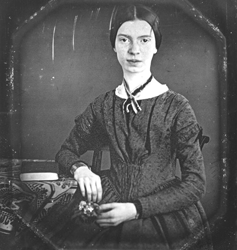|
Emily Dickinson
Answer
to Name
This Famous Person Game - October 2013
|
 |
Those who correctly identified Emily Dickinson were: Faye Gaston of Union Springs, Ala.; Teresa P. Bland; Julie Kimbrell of the Old School Antique Mall in Sylva, N.C.; Ted Carlton of Utah; Ruth Weston of Time Was Antiques; Mitch Pettross; Heaven Lee Haseleu; Scott and Carolyn Brown of Memories Flea An'Tique Mall in Prattville, Ala.; and Kay Cotton of Peachtree City, Ga.
Faye Gaston pointed out that one of Emily’s most famous poems is:
Not In Vain
If I can stop one heart from breaking,
I shall not live in vain;
If I can ease one life the aching,
Or cool one pain,
Or help one fainting robin
Unto his nest again,
I shall not live in vain.
|

Emily Dickinson, ca. 1848.
(Photo, courtesy of the Todd-Bingham Picture Collection and Family Papers, Yale University.)
|
Emily Dickinson rarely titled her poems, including this one, so you can see them listed under different names chosen by readers or editors compiling books of her poems.
Only ten of Emily Dickinson’s poems were published during her lifetime, and all were published anonymously1, either without her permission or without her desiring credit. She was a private person, not knowing fully recognizing her own talent. It was not until after her death that her sister Lavinia found almost 1,800 of her poems. Books of them were published later, and they sold well and were often reprinted.
The brain is wider than the sky.
Emily’s family and close friends knew she was a poet because she often gave them poems as presents or with gifts of flowers. In addition to poetry, she was also an accomplished gardener and amateur botanist, have collected and categorized hundreds of plants and flowers she grew in the gardens of her father’s house. Her ability in gardening was better known in the town of Amherst, Mass., where she was born than were her poems.
Emily had reddish hair, played the piano and was an excellent baker. After schooling, she lived at home with her family. When her mother became bedridden, Emily tended her and the house for more than 30 years.
Forever is composed of nows.
The loss of many loved ones, family and friends, was a great trial for Emily during her life. She lost her father and mother, a nephew at age eight, friends, and a possible suitor later in life, Judge Otis Lord of the Supreme Judicial Court of Massachusetts.
Because I could not stop for death,
He kindly stopped for me;
The carriage held but just ourselves
and immortality.
It is not known if the trauma of death added to her becoming a recluse later in life or if she was agoraphobic, but starting in the late 1860s, she did not leave the property, and soon thereafter, she did not leave her room. She maintained her relationships with friends through correspondence, at which she was prolific. It is unfortunate that she asked her sister Lavinia to burn her letters after her death, but Lavinia honored her wishes. Even so, hundreds of letters to friends and relatives remained for posterity’s sake. Lavinia did save the many poems Emily did not specifically direct her to burn. Because of them, Emily Dickinson is considered one of America’s greatest poets.
Saying nothing... sometimes says the most.
Born on December 10, 1830, Emily Dickinson died of Bright’s Disease on May 15, 1886. Bright’s Disease was the name given to all forms of kidney disease at the time.2 She probably suffered great pain for at least two years from it.
I do not like the man who squanders life for fame;
give me the man who living makes a name.
Virtually unknown during her lifetime, Emily Dickinson is now one of the most famous female poets in the world. She is consistently included in all the lists of the top poets of all time.
And yet—
This is my letter to the world,
That never wrote to me,--
The simple news that Nature told,
With tender majesty.
Her message is committed
To hands I cannot see;
For love of her, sweet countrymen,
Judge tenderly of me!
--------------------------------------
1EmilyDickinsonMuseum.org.
2 Other notables who have suffered or died from Bright’s Disease are: Alexander III, Czar of Russia; the 21st President Chester A. Arthur; baseball legend Ty Cobb; Robert Wood Johnson, CEO of Johnson & Johnson; Al Ringling of the Ringling Brothers Circus; Richard Sears of Sears, Roebuck and Company; and Bram Stoker, author of Dracula.
Learn
about more Famous People
|